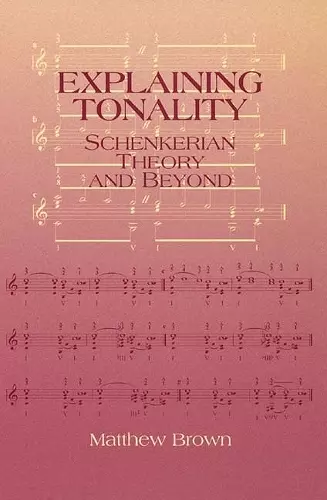Explaining Tonality
Schenkerian Theory and Beyond
Format:Hardback
Publisher:Boydell & Brewer Ltd
Published:30th Jun '05
Currently unavailable, and unfortunately no date known when it will be back

This book offers a comprehensive examination of Schenkerian analysis and its relevance in understanding tonality in music, from Bach to contemporary composers.
In Explaining Tonality, Matthew Brown presents a thorough defense of Schenkerian analysis, focusing on the concept of tonality in music. The book examines a wide array of compositions, spanning from the works of Bach to those of Mozart and Brahms, all of which utilize tonality as a central element. Tonality, defined as the tendency of music to center around a stable pitch or tonic, is a term that often confounds musicians and theorists alike. Brown delves into the intricacies of this concept, illuminating the various interpretations and understandings that have emerged over time.
The author highlights the comprehensive theories developed by Heinrich Schenker in his influential three-part treatise, Neue musikalische Theorien und Phantasien. Schenker's systematic approach to analyzing the behavior of musical lines and chords—both within individual phrases and across entire compositions—serves as a cornerstone for Brown's arguments. Throughout Explaining Tonality, the author articulates the advantages of Schenker's methods compared to those of his contemporaries, providing a compelling case for their continued relevance in contemporary music theory.
Moreover, Brown proposes extensions of Schenker's theories to encompass tonal features in compositions predating Bach, such as those by Monteverdi, as well as works by later composers like Debussy and Stravinsky. The book also introduces six methodological criteria for evaluating theories of tonality, ultimately revealing how a deeper understanding of tonality can illuminate broader aspects of musical composition. In its conclusion, Explaining Tonality suggests pathways for the future development of Schenkerian theory.
The question that Matthew Brown has set himself to answer is, basically, just how fundamental Schekerian analysis actually is. . . He seeks nothing less than a rigorous examination of the theory to see if it is logically consistent, sufficiently explanatory without being unneccessarily complex, and ultimately useful. . . . His range is enormous, and one cannot do adequate justice to what has been achieved here without detailed musical exemplification. The musical repertory ranges from early Baroque to the twentieth century. -- William Drabkin, University of Southampton * MUSIC AND LETTERS, May 2008 *
Explaining Tonality is a cogent, concise, and eminently readable study of one of music theory's most important subjects. Matthew Brown traces the philosophical and psychological contexts within which Schenkerian theory can be placed, and considers other relevant topics, such as strict counterpoint and nineteenth-century chromaticism, by way of a wealth of freshly observed compositional examples. Technically expert and critically evenhanded, this absorbing exploration of tonality in theory and practice sets new standards in its scope and authority. -- Arnold Whittall, King's College, London
Matthew Brown's Explaining Tonality: Schenkerian Theory and Beyond carefully sets out a well-reasoned and convincing case for the scientific viability and logical foundations of Heinrich Schenker's extraordinary approach to analyzing tonal music, revealing the solidity of its foundations. His work should be read by anyone who has an interest in the epistemology of music theory. -- Frank Samarotto, Indiana University
I . . . heartily recommend the book, for I know of none better in its field. It offers dozens of 'ear-engaging' analyses of important musical works, including an entire chapter on the music of Debussy. These analyses alone make it a must-read for anyone seriously interested in contemporary music theory. -- Edward Green * MUSIC EDUCATORS JOURNAL *
ISBN: 9781580461603
Dimensions: unknown
Weight: 650g
315 pages